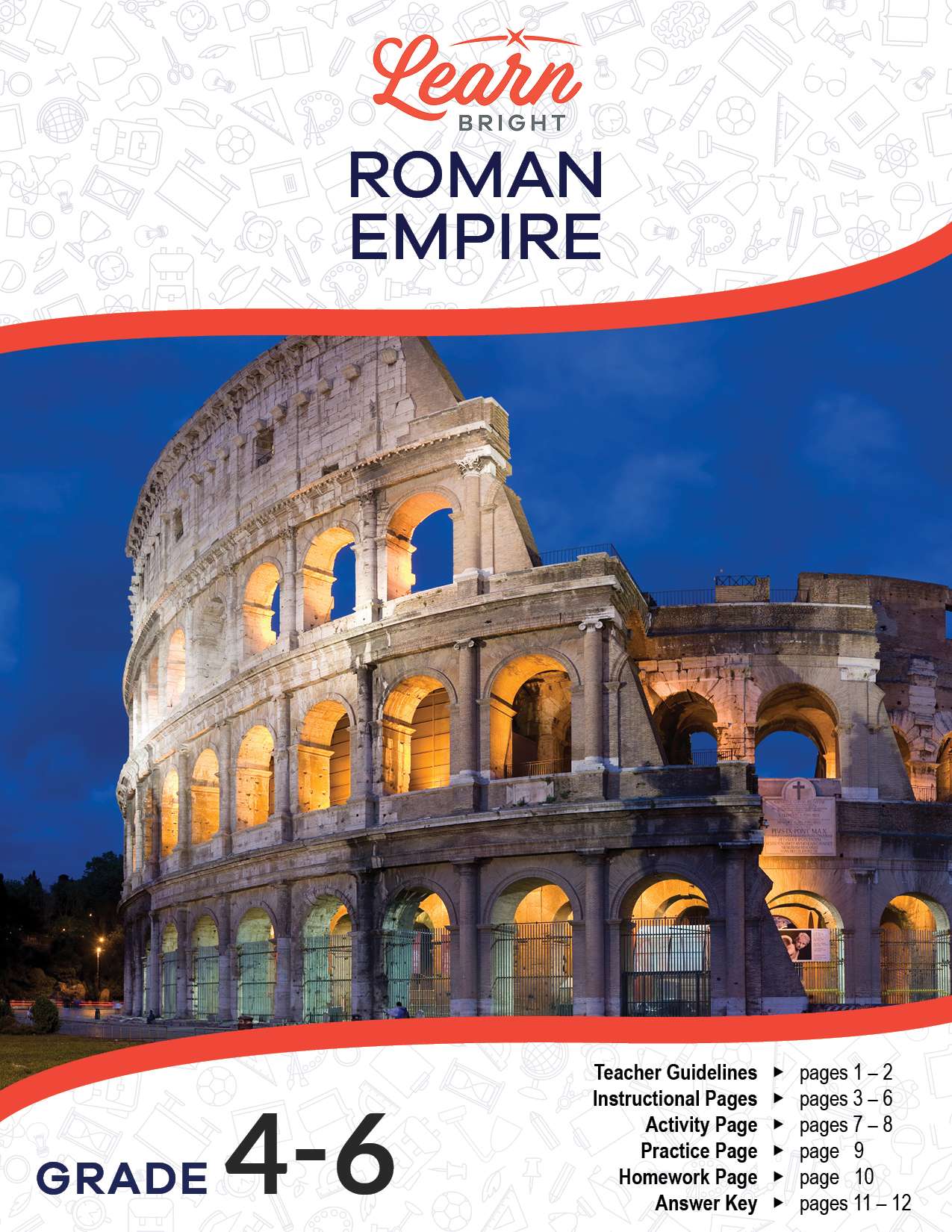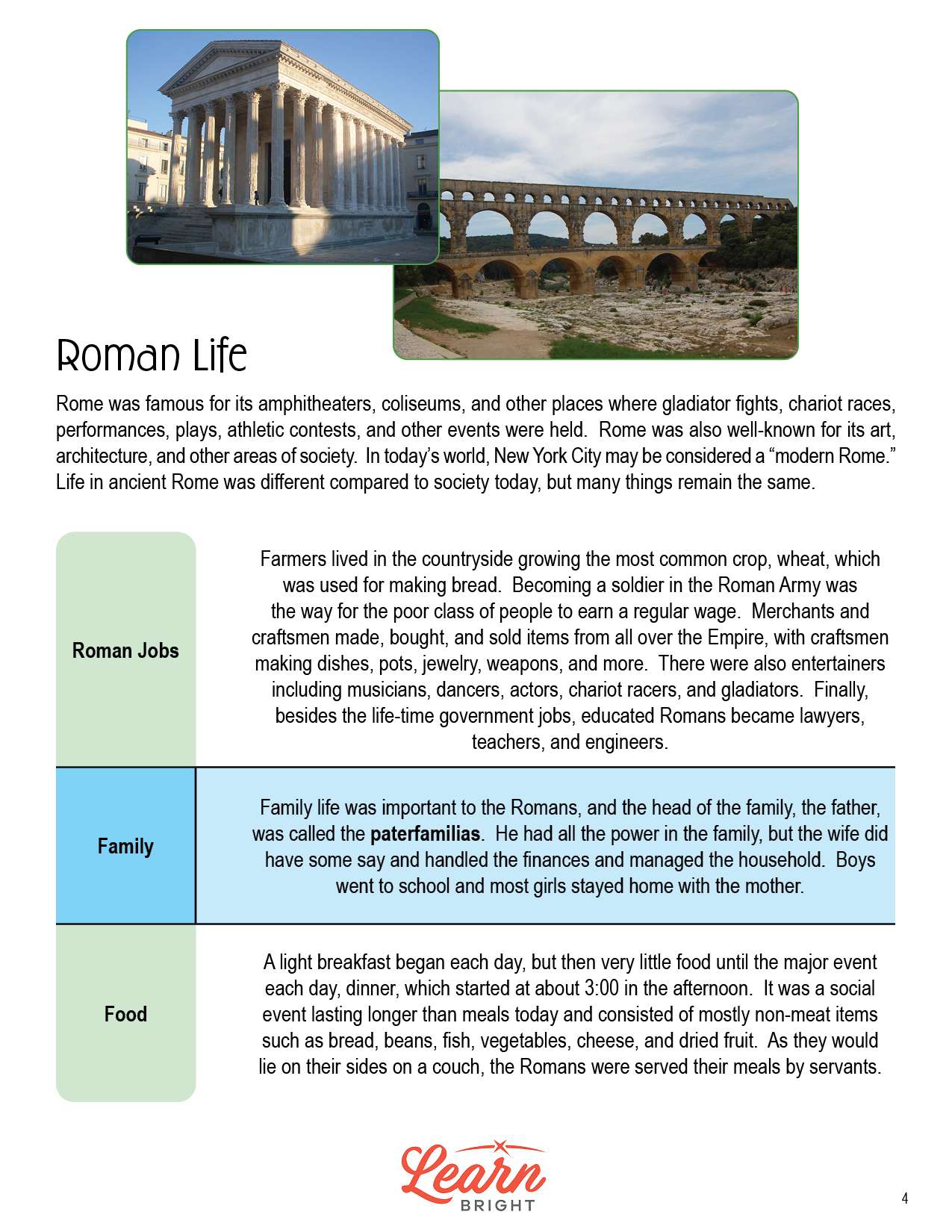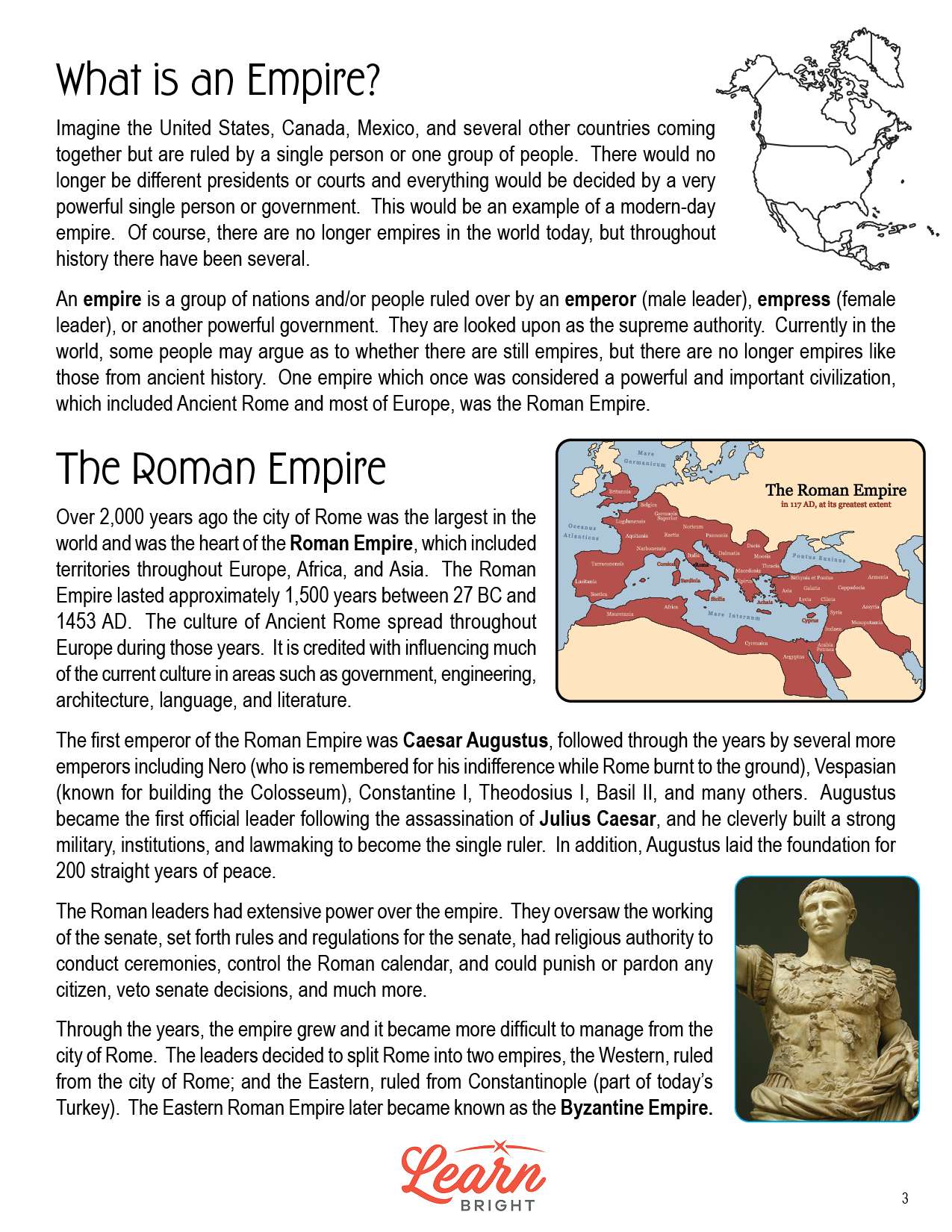Description
What our Roman Empire lesson plan includes
Lesson Objectives and Overview: Roman Empire lesson plan explores the rise and fall of the Roman Empire, including the most common historical events and significant contributions of its people. At the end of the lesson, students will be able to describe and identify the Roman Empire, and its events and people during its period in history. This lesson is for students in 4th grade, 5th grade, and 6th grade.
Classroom Procedure
Every lesson plan provides you with a classroom procedure page that outlines a step-by-step guide to follow. You do not have to follow the guide exactly. The guide helps you organize the lesson and details when to hand out worksheets. It also lists information in the orange box that you might find useful. You will find the lesson objectives, state standards, and number of class sessions the lesson should take to complete in this area. In addition, it describes the supplies you will need as well as what and how you need to prepare beforehand.
Options for Lesson
Included with this lesson is an “Options for Lesson” section that lists a number of suggestions for activities to add to the lesson or substitutions for the ones already in the lesson. One optional adjustment to the lesson is to use the homework assignment as a class activity and group students in 3s or 4s to discuss the implications if a similar problem occurred today. You can plan a “Roman Empire Week”, with each day focused on a different aspect of Ancient Rome and the Roman Empire. You could also assign each student a different aspect of the empire to research and report to the class, like emperors, Roman Mythology, The Colosseum, Rome, Pompeii, daily life, and more. Finally, you could organize a class period for students to play games like the Roman children.
Teacher Notes
The teacher notes page includes a paragraph with additional guidelines and things to think about as you begin to plan your lesson. This page also includes lines that you can use to add your own notes as you’re preparing for this lesson.
ROMAN EMPIRE LESSON PLAN CONTENT PAGES
What is an Empire?
The Roman Empire lesson plan includes four pages. If the countries of the United States, Canada, Mexico, and more came together and a single person ruled over them all, it would be an example of a modern-day empire. We don’t have any empires today, but there have been several major empires throughout history.
Empires are groups of nations and/or people ruled by an emperor, empress, or a powerful government, who the people saw as a supreme authority. Today, some people disagree about whether or not we still have empires, though we all agree that there are no empires like the ones that used to exist. The Roman Empire was a particularly important and powerful civilization which included Ancient Rome and most of Europe.
The Roman Empire
More than 2,000 years ago, the city of Rome was the largest city in the world. It was also the heart of the Roman Empire, which included territories from Europe to Asia to Africa. The Roman Empire lasted for about 1,500 years, from 27 BC to 1453 AD. Ancient Rome’s culture spread throughout the territory and, today, we credit it with influencing many modern things, like our governments, engineering, architecture, language, literature, and more.
Caesar Augustus was the first emperor of the Roman Empire. There were many other emperors after him, like Nero, who was not concerned when the city burned to the ground; Vespasian, who built the Colosseum; Constantine I; Theodosius I; Basil II; and many more. Augustus became the first leader after the assassination of Julius Caesar. Augustus built a strong military, institutions, and lawmaking to help himself become a single ruler. He also laid the foundation for 200 years of peace.
Roman leaders had extensive power, overseeing the senate, setting rules and regulations, holding religious authority and conducting ceremonies, controlling the calendar, punishing and pardoning citizens, and vetoing senate decisions.
The empire grew over the years and became difficult to manage from Rome, so the leaders decided to split it into two empires. The Western empire ruled from Rome, while the Eastern ruled from Constantinople, which we now know as Turkey. The Eastern Roman Empire became known as the Byzantine Empire later on.
Roman Life: Jobs, Family, Food
Rome became famous for the amphitheaters, coliseums, and other places where they held gladiator fights, chariot races, performances, plays, athletic contests, and other events. We also know it for its art, architecture, and other innovations. Today, you might consider New York City a modern Rome. Life back then was very different, though some things have stayed the same.
Romans had many different jobs. In the countryside, farmers grew wheat, which they used to make bread. Poor people often joined the Roman Army in order to earn a regular wage. Merchants and craftspeople made, bought, and sold items in Europe. Craftsmen made dishes, pots, jewelry, weapons, and more. They also had entertainers, like musicians, dancers, actors, chariot racers, and gladiators. Educated Romans, on the other hand, often became lawyers, government workers, teachers, and engineers.
The Romans placed lots of importance on their families. They called the head of the family, the father, the paterfamilias. The father had most of the power, but wives also made some decisions and handled the household finances. Boys went to school while girls stayed home.
Romans began their day with a small breakfast. They ate most of their food at dinner, which started around 3:00. Their dinners were social events that lasted a long time. They ate bread, beans, fish, vegetables, cheese, and dried fruit rather than meat. Wealthy Romans would lie on their sides while servants fed them.
Roman Life: Clothing, School, Religion, and Leisure Time
Romans often wore togas, or long white robes made of wool or linen. Some togas had special colors that indicated the wearer’s status in society. they usually only wore them in public because they were uncomfortable to wear. Poor Romans wore tunics, which looks like an extra long t-shirt. Later on, tunics became popular with all Romans because of how comfortable they were.
Poor children didn’t go to school. Wealthier boys went to school starting at age seven, while tutors taught some girls at home. Schoolmasters, or tutors, were strict. They took education very seriously. Many of the subjects they had were similar to the subjects we have today. They used Roman numerals for math. They also learned weights and measurements, philosophy, and public speaking.
Religion played a big role in people’s everyday lives, though they did not visit temples or churches. Instead, they had small shrines in their homes dedicated to Roman gods and goddesses, who they believed lived on Mount Olympus.
After dinner, people did activities. They enjoyed music, art, dancing, reading, and sports. They attended plays, the chariot races, and gladiator fights. Men and boys went to Roman baths to wash, sit, and talk. These baths also included gardens, gyms, libraries, and other recreational activities, like modern recreation centers.
The Fall of the Roman Empire
You’ve probably heard of the Fall of the Roman Empire. This refers mostly to the fall of the Western Roman Empire. The Roman Empire was the world’s biggest superpower for many years. We have several different theories and factors about why it ended.
Tribes defeated the Empire’s military and took control of some territories within the Roman Empire. The slave trade also began to decrease, and Roman society depended greatly on slave labor. The Empire also divided itself in half; this caused problems between the east and west as they fought over resources, territories, and military aid.
The military weakened because they did not have enough soldiers to support the growing Empire and protect its territories; new soldiers also did not care about Rome. Christianity grew in popularity and became the state religion in the late 300s; this lessened the god-like status of the Roman Empire. They also had frequent internal and political issues, leading to instability; this gave their enemies the ability to take over.
The city of Rome is the capital city of Italy today, and is located in the same place as the ancient city. Many original buildings from that time still exist today, like the Roman Colosseum and Forum. The Circus Maximus could hold 150,000 people in its time, and pieces of it still exist in Rome.
Ancient Rome and the Roman Empire had a lot of influence on our lives today, and historians consider it to be one of the most significant periods in history.
Key Terms
Here is a list of the vocabulary words students will learn in this lesson plan:
- Empire: Group of nations or territories ruled by one person or group
- Emperor: The male leader of an empire
- Empress: The female leader of an empire
- Roman Empire: Includes territories throughout Europe, Africa, and Asia
- Ceasar Augustus: The first emperor of the Roman Empire
- Julius Ceasar: Emperor assassinated prior to the Roman Empire
- Byzantine Empire: The name later given to the Eastern Roman Empire
- Paterfamilias: The name the father was called in a Roman family
- Toga: A long white robe made of wool or linen
- Tunic: A T-shirt-like shirt worn mostly by poor Romans
- Schoolmasters: Teachers were referred by this name in Roman schools
- Circus Maximus: A stadium for chariot races, which held 150,000 people
ROMAN EMPIRE LESSON PLAN WORKSHEETS
The Roman Empire lesson plan includes three worksheets: an activity worksheet, a practice worksheet, and a homework assignment. You can refer to the guide on the classroom procedure page to determine when to hand out each worksheet.
A DAY IN OUR LIFE ACTIVITY WORKSHEET
Students will work in pairs to complete the activity worksheet. Each pair will plan their day using the provided information about family life in the Roman Empire, including as many details as possible.
Students can also work alone to complete the worksheet.
MATCHING PRACTICE WORKSHEET
The practice worksheet asks students to match 15 terms with their definitions. They will also answer five questions about the lesson material.
ROMAN EMPIRE HOMEWORK ASSIGNMENT
For the homework assignment, students will review each reason attributed to the fall of the Roman Empire and tell how that reason could cause problems for a modern city, state, or country.
Worksheet Answer Keys
This lesson plan includes answer keys for the practice worksheet and the homework assignment. If you choose to administer the lesson pages to your students via PDF, you will need to save a new file that omits these pages. Otherwise, you can simply print out the applicable pages and keep these as reference for yourself when grading assignments.









